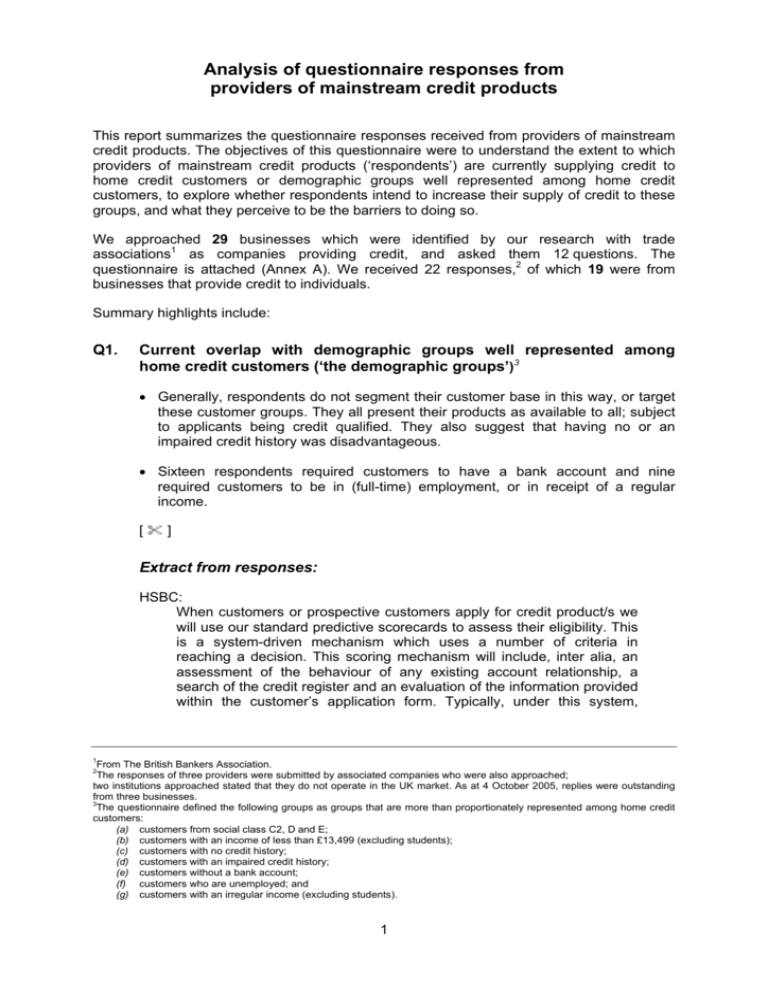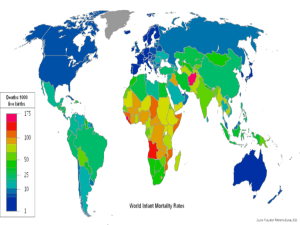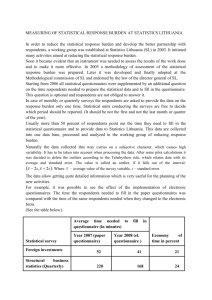Analysis of questionnaire responses form providers of mainstream
advertisement

Analysis of questionnaire responses from providers of mainstream credit products This report summarizes the questionnaire responses received from providers of mainstream credit products. The objectives of this questionnaire were to understand the extent to which providers of mainstream credit products (‘respondents’) are currently supplying credit to home credit customers or demographic groups well represented among home credit customers, to explore whether respondents intend to increase their supply of credit to these groups, and what they perceive to be the barriers to doing so. We approached 29 businesses which were identified by our research with trade associations1 as companies providing credit, and asked them 12 questions. The questionnaire is attached (Annex A). We received 22 responses,2 of which 19 were from businesses that provide credit to individuals. Summary highlights include: Q1. Current overlap with demographic groups well represented among home credit customers (‘the demographic groups’)3 • Generally, respondents do not segment their customer base in this way, or target these customer groups. They all present their products as available to all; subject to applicants being credit qualified. They also suggest that having no or an impaired credit history was disadvantageous. • Sixteen respondents required customers to have a bank account and nine required customers to be in (full-time) employment, or in receipt of a regular income. [] Extract from responses: HSBC: When customers or prospective customers apply for credit product/s we will use our standard predictive scorecards to assess their eligibility. This is a system-driven mechanism which uses a number of criteria in reaching a decision. This scoring mechanism will include, inter alia, an assessment of the behaviour of any existing account relationship, a search of the credit register and an evaluation of the information provided within the customer’s application form. Typically, under this system, 1 From The British Bankers Association. The responses of three providers were submitted by associated companies who were also approached; two institutions approached stated that they do not operate in the UK market. As at 4 October 2005, replies were outstanding from three businesses. 3 The questionnaire defined the following groups as groups that are more than proportionately represented among home credit customers: (a) customers from social class C2, D and E; (b) customers with an income of less than £13,499 (excluding students); (c) customers with no credit history; (d) customers with an impaired credit history; (e) customers without a bank account; (f) customers who are unemployed; and (g) customers with an irregular income (excluding students). 2 1 customers in groups (b) to (g) will not score highly. [See footnote 3 for definition of groups (a) to (g).] Q2. Products directly aimed at or widely used by the demographic groups • None of the 19 respondents who lent to individuals has products that are directly aimed at these groups. However, all say that all of their products would potentially be open to these groups, and RBS said that its Style card4 is predominantly used by these groups. Q3. Planned expansion of supply to the demographic groups • None of the 19 respondents who lent to individuals cited plans to expand into these market segments. Extracts from responses: Royal Bank of Scotland(RBS)/NatWest: However, we do already, and will continue to lend to individuals in these various groups as a consequence of our wider business strategy, subject to their ability to repay and ID verification checks. Our business model is based around delivery through a multi-channel infrastructure of branches, telephony, and internet to a broad and very diverse mass-market customer base across the UK. [] Q4. Appetite for expansion of supply to the demographic groups • None of the 19 respondents expressed an interest in expanding credit products to these demographic groups. This lack of appetite was mainly explained by inconsistency with low-risk business model and with their responsible lending policies. Extracts from responses: RBS/NatWest: Targeting these individual sub-sectors is likely to be resource intensive and on a small scale, which does not suit the scope or nature of our business model. Bank of Ireland:5 We are concerned only to accept customers who have the ability to afford repayments. There is no advantage to either side to accept customers who cannot meet those commitments, as ultimately both parties will lose out. Application assessment is based on long experience in this market and now distils that acquired experience into the credit policy and scoring models that are used to assess customers. As we do not specifically 4 [ ]. The Bank of Ireland stated that it does not fall within the full definition of ‘home credit’ as set out in the terms of reference for this inquiry. It notes that ‘products are provided to the total market, and it does not specifically target the Group referred to at Q1; rather all applications for credit are subject to status and standard credit policies hence it does not specifically discriminate against them either’. 5 2 exclude customers covered by question 1, it is only the issue of affordability that prevents the loan application being acceptable. We are therefore neither deterred nor encouraged to alter our current stance. Capital One: There are a number of factors limiting our appetite to supply credit to the groups listed. The key considerations are: • Overall credit risk characteristics of the groups concerned, our commitment to responsible lending and our need to manage our overall corporate credit loss rate. • Economic viability of extending credit given credit risk and operational cost considerations, whilst maintaining pricing that we consider to be fair to the consumer. • Concerns over consumer indebtedness and ability of individual consumers to service their debt burden. In particular lack of full visibility of existing credit commitment through the credit reference agencies is a particular concern. • Absence of credit performance data records at the credit reference agencies, making the assessment of applicant risk and ability to service new commitments difficult and inaccurate. This results in many consumers being declined and/or not solicited through absence of any positive data. Co-operative Bank: The Bank’s market strategy and branding is consistent across credit and saving products and is primarily aimed at customers with an ABC1 profile, based on the Bank’s assessment of its points of differentiation in the market and best customer value. A move into the customer groups identified in Q1 would require the Bank to change its approach to brand and customer strategy, and its distribution capability, including the cost to acquire and serve. Q5. Restraints on product availability • All of the 19 respondents who lent to individuals said that all products are open to all applicants, subject to status. Q6. Assessment risk process • All of the 19 respondents who lent to individuals said they use credit reference bureaux (CRBs) and scorecards. Eleven of these also refer to the use of a manual underwriting process. Where manual underwriting exists, it is generally used to interpret and fine-tune the results of CRB analyses. Extracts from responses: RBS/NatWest: Our credit assessment processes are underpinned by our use of credit scoring, which includes a credit reference search and fraud checks. This is supplemented by affordability checks, as well as verification of information provided by the customer. 3 All lending applications are subject to automated credit score and a decision provided by the system. The majority of our credit scorecards are built in-house to industry standards. Occasionally we use reputable external scorecard builders to ensure our internal process is adopting industry best practice. Typical information for a standard application includes age, income, other borrowings, address/previous address and employment details. Verification of information provided by the customer can involve manual checks to ensure there are no inconsistencies. [] Q7. Documentation required • Of the 19 respondents who lent to individuals, all require completion/submission of documentation in addition to proof of identity and address, which is stipulated by money laundering regulations. Requirements include, but are not limited to, proof of income; production of pay slips; employment verification and/or bank statements/reference; and CRB searches. Q8. Type of bank account required • Of the 19 respondents who lent to individuals, 16 require bank accounts (within which one requires a current account; seven specify an account with direct debit/standing orders functionality and one explicitly encourages its own accounts). Of the three lenders who do not require a bank account, one adds that the absence of a bank account will reduce the chance of an application being approved. Q9 and Q10. Geographic exclusions/restrictions • Of the 19 replies, only one reported a limit on UK-wide availability of its products— credit is only available in localities where it has a branch. Extracts from responses: Alliance & Leicester: There are no restrictions on lending to any areas of the UK. As a direct bank, with a high street presence, primary channels include telephone and internet and every application is assessed on its own merits. CitiFinancial Europe plc:6 Our credit is available in all parts of the UK. We have approximately 120 branches and 90 per cent of the population is within 45 minutes driving time of one of our branches. Q11. Use of home credit repayment history 6 CitiFinancial Europe plc is an affiliate of Citibank International plc. 4 • Of the 19 replies, none currently use payment books in their assessment of the individual; ten expressed willingness to consider home credit repayment histories as part of a CRB report. Extracts from responses: RBS/NatWest: We do not currently ask for information about customers’ history of repaying home credit loans. However, such data would be used if included in standard data made available via the credit reference agencies. American Express: Yes. If there have been reported arrears or defaults on the credit bureau, then we will incorporate this information into the application decision. ARG: The only credit information that is accessed is from the [ ] database. This will include any shared data provided by home credit organisations but this information is not used in any specific or unique way. Centrica: Only if this data were supplied in the prescribed format to the credit reference agency would this information be used to assess applicants’ credit worthiness. Capital One: … difficult to integrate this [payment book] into our automated credit decisioning process and interpretation would require underwriting staff with different skills … the non-availability of this payment data in electronic form harms our ability to offer credit products on attractive terms to the consumer segments listed ... and will make it very difficult for these consumers to gain access to mainstream credit products. Co-operative Bank: The bank does not request any such information and would only utilise it if it were available from CRA. MBNA Europe: MBNA Europe makes use of all available credit bureau information when considering an application for credit. Additional information, such as payment books, may be requested where bureau information is missing, to confirm an applicant’s stability, ability and willingness to pay. National Australia Group: NAG does not specifically request information on customers’ home credit repayment history when considering application for credit products. However, if the repayment history is listed with [CRA], NAG will naturally appreciate the information in the scoring models. Q12. Considered supplying home credit • 22 of 22 said ‘no’. Their reasons were also outlined in responses to Q4. and include: 5 Extracts from responses: ARG: GUS plc exited the home credit market in 2003 when it sold Morses Ltd as part of the disposal of the UK Home Shopping mail order businesses to March UK Ltd. It is unlikely that there would be a return to the market as our core competency is in centralised lending, we would not use the retail chains of Argos Retail Group to offer this type of financial product and we have no sales/ collections force which could be used to launch into this market. Capital One: We have never considered supplying home credit in the UK. We believe that the business model has inherently high operating costs and small loan sizes. We believe the consequence of this is that credit cannot profitably be offered at price points that are attractive to the consumer. CitiFinancial Europe plc: The business has (but not in the recent past) reviewed this market. The principal reason why we would not enter into it is because of the need to provide an extensive workforce and lack of appetite for credit risk. Cooperative Bank: The Bank has not considered the home credit market specifically, although it has reviewed the opportunity to offer credit to customer groups outside its existing primary target market. The Bank has concluded that it cannot make an internal economic business case for sales and service into these customer groups. In addition, with reference to cash collections, the Bank does not currently have the operational capability to make these collections as carried out in the Home Credit market. RBS/NatWest: Our current view is that the economics of small sum loans with relatively high fixed costs of origination and servicing appear unattractive, and we do not have relevant experience in this market. 6 ANNEX A Home credit inquiry: questionnaire to providers of other forms of credit Your company’s supply of credit products to the traditional home credit customer base 1. The following groups are more than proportionately represented among home credit customers, compared with the population as a whole. a. b. c. d. e. f. g. Customers from social class C2, D and E Customers with an income of less than £13,499 (excluding students) Customers with no credit history Customers with an impaired credit history Customers without a bank account Customers that are unemployed Customers with an irregular income (excluding students) Please describe the extent to which you currently supply credit products to customers from these groups. Note: Insofar as you are able, please provide factual information (for example from market research conducted with your customers or with customers more generally) to support your answer. 2. Do you currently supply any credit products which are either directly aimed at or widely used by any of the groups described in question 1? Please provide a list of all such products. Please provide the following information about all credit cards, overdrafts and unsecured personal loans on this list: a. A description of the product and its key features b. Any restrictions on who is eligible c. The extent to which the product is targeted at any of the groups in question 1, or is sold to all of your customers. d. Any restrictions on the maximum or minimum amount that can be borrowed e. The range of APRs that you charge for this product f. Details of any other charges (for example for unauthorised borrowing or missed payments) g. Overall customer numbers and outstanding balances for this product h. An indication of customer numbers within the groups described in question 1. 3. Do you have any plans to expand your supply of credit products to any of the groups described in question 1? If so how will you carry them out? 4. What, if anything, deters you from expanding your supply of credit products to any of the groups described in question 1? 5. Are there any credit products that you would not want to offer to existing or new customers? If so, please give reasons. Requirements to take out credit with your company 6. Please describe your processes for assessing the credit risk of a new customer and an existing customer when applying for a credit product such as an overdraft, credit card or low value personal loan. Please cover: 7 a. Your use of credit reference agencies b. A description of the credit scoring model that you use (including the factors used, such as the customer’s address, and the relative weight associated with each factor) c. The information that you request from potential customers in order to evaluate credit risk d. The extent to which these applications are manually underwritten. e. Any single factors which would terminate any credit application (such as a history of fraud) f. The extent to which this process varies between the credit products that you offer 7. What documentation would a new customer need to produce in order to take out credit with you? 8. What sort of bank account, if any, would be needed for a customer to take out credit with you? 9. Are there particular parts of the UK in which you would not usually offer credit products? If so, why and where are they? 10. How are any such areas identified (e.g. by your company or by a credit reference agency)? 11. Do you currently ask for or make use of any information about customers’ history of repaying home credit loans (e.g. a payment book) when considering applications for credit products? Entry into home credit 12. Have you ever considered supplying home credit in the UK? If so please give details. If not, please explain why not. Notes for completion of this questionnaire 1. By “credit products” we mean all forms of financial accommodation including personal loans, overdraft facilities, voucher agreements involving an element of credit, credit cards, HP financing, other hire arrangements for periods exceeding 3 months, sale of goods on credit, conditional sale agreements, and sale and buy back agreements to customers. 2. “Home credit” means the provision of credit, typically small sum cash loans, the repayments for which are collected in instalments (often weekly or fortnightly) by collectors who call for that purpose at the customer’s home. 3. If you wish to discuss this questionnaire, please contact Adam Land on 020 7271 0171 or adam.land@competition-commission.gsi.gov.uk PLEASE DO NOT HESITATE TO CONTACT US IF YOU HAVE ANY DOUBTS AS TO HOW QUESTIONS SHOULD BE INTERPRETED 8








